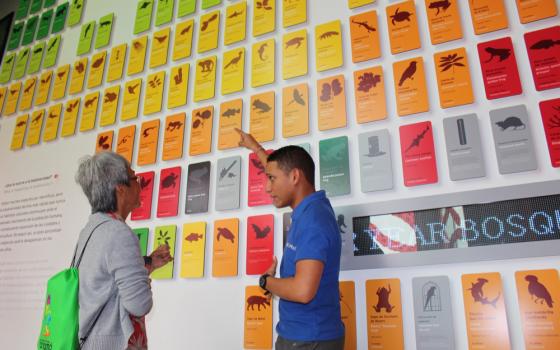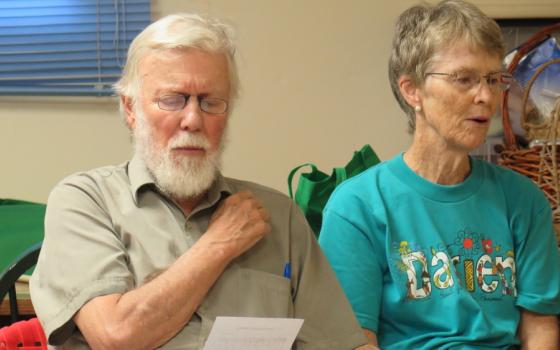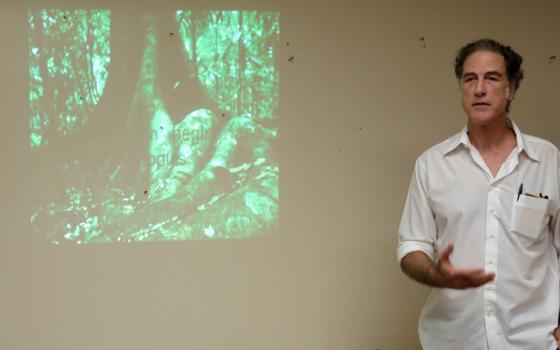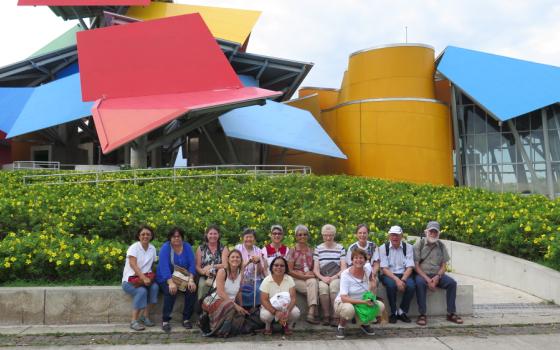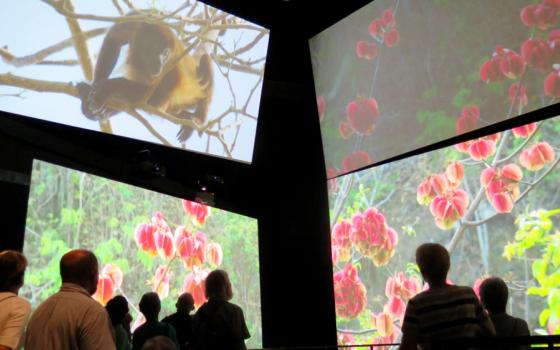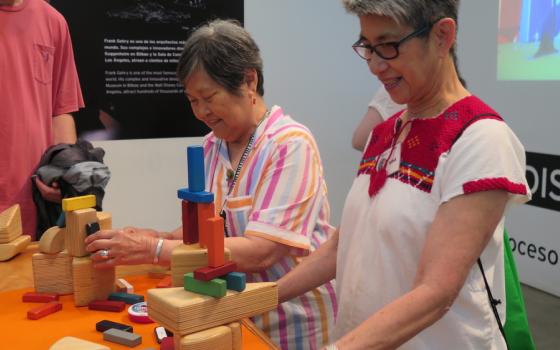"Consciousness waking, Holy and Whole
Creation's stirring, birthing anew
Now is the time. We are the space
for the Holy to rise in our midst."
— Jan Novotka, "Consciousness Waking"
Tropical sunrise comes early, and so does the order of the day at the Web of Life retreat. Early morning rituals included an invocation of the four directions by David Molineaux, with a pinch of yerba mate from his home in Chile as the offering.
Jan Novotka's song awakened whatever heart might still be slumbering in a simple water ceremony, where each expressed his or her intentions for the day and deposited them in the bowl of water for safekeeping.
Then it was on to the subject of the day: Panama's importance in the history of planet Earth. As it turns out, it's a role that's hard to exaggerate. Nearly 3 million years ago, the iconic land bridge fatefully emerged from the ocean, joined two continents and divided a vast ocean in two. The shift opened a bridge to a massive migration of species, shifted ocean currents, triggered an ice age, and may have even been responsible for creating the conditions that led to the evolution of the human species.
That was the dramatic scenario Patrick Dillon laid out for the group, who were on an eco-spirituatly retreat organized by the Maryknoll Sisters. Dillon worked alongside Frank Gehry as executive architect for the celebrated Biomuseo, or Museum of Biodiversity, in Panama City.
"In some ways, we are all Panamanians," said Dillion, quoting Steven Stanley's Children of the Ice Age in a theme repeated later in the day by museum audio guides.
Dillon, who grew up in the canal zone the third of four brothers, spent the morning with the Web of Life group sharing some of his experience working with the team at the Biomuseo. He recalled the first meeting with the Smithsonian curators in Washington, D.C., when one curator stood up and congratulated the team.
"He found it ironic that the site is on the edge of the Panama Canal, which some consider to be the most monumental transgression of mankind against nature," Dillon said. "What took 3 billion years for nature to put together, man has come and severed."
Dillon said he was taken aback. "I never thought of it in terms of how it disconnects North and South America," he said. "We always talked about how it connected the world."
The challenge in designing the museum was to have an impact that could be grasped in 15 minutes by the casual cruise-line passenger or absorbed in a whole day by a researcher looking for serious information.
Eight galleries and eight "devices of wonder" get the point across with impact. One of the biggest "wow" factors comes with the Panamarama, a three-story, 10-screen IMAX-style experience that carries the viewer to the top of the rainforest canopy with the toucans and morpho butterflies, then plunges them to the depths of the ocean with the whales and coral.
The next "device of wonder" is a jaw-dropping gallery called "Worlds Collide," depicting the Great American Biotic Interchange. A stampede of megafauna looms overhead, capturing Panama at that critical moment in geological history when North and South America, separated by an ocean for 70 million years, were connected. Land sloths the size of elephants, cow-sized armadillos and the terror bird made their way north from South America, while saber-toothed tigers, mastodons and horses headed south. The encounter benefited some species but eradicated others.
"Imagine the first humans arriving in Panama and encountering the land sloths," Dillon said. "They were vegetarians, and they were these slow, lumbering mountains of meat that could easily be slaughtered and barbecued."
Dillon's fascination with the theme led him to many discussions with Anthony Coates of the Smithsonian Tropical Research Institute, a paleogeologist who, according to Dillon, inspired Gehry to build the Biomuseo by telling him the dramatic story of the Panama land bridge.
Coates showed Dillon a model he had made of the Earth's surface over 5 billion years, a form floating in space with a single land mass called Pangaea. It showed how the forces of plate tectonics forced that form into the seven continents, a process that is still at work today.
"I asked Tony, 'Can you show me what happens in the next 5 billion years?' And he said, 'As a matter of fact, I have that model.' " Coates' animation showed everything moving slowly back together over the course of another 5 billion years.
"His animation showed that basically everything comes back to Pangea," Dillon said. "What that suggested to me was a heartbeat — it's just that there's 10 billion years between beats. And what's 10 billion years if you're talking about eternity?"
Dillon doesn't describe himself as a nonbeliever, nor is he a practicing Catholic. Rather, he seems content to let the mystery be.
But his account sparked the imaginations of the Web of Life participants. Clara Meza, a missionary who has been working at the Santa Fe Pastoral Center in Darién for the past three years, found it profoundly moving.
"As I listened to him describe this, it struck me and I said, 'That's God,' " she said.
Ixchel Menéndez, a Panamanian mother of two who has volunteered with the Fundación Nueva Vida for several years, was moved by the museum's exquisite portrayal of the natural world — and stricken by remorse.
"I saw that God created nature so perfectly. It provides for our every need," she said. "And yet when I see a cockroach or a scorpion or a chacacha [gecko], I reach for the Baygon [insect repellent] because I'm afraid. I see the oceans of Panama filled with trash and I feel so ashamed. And then there are these toxic chemicals we are poisoning everything with. There's so much beauty in the world, and we don't know how to appreciate it because of our fear."
Maryknoll Sr. Linda Donovan, who has been living in Chile since 1981, has seen transition on many levels.
"The word going through my mind is 'shift,' " she said. "It's all around me, and I've chosen not to see it."
Panama in many ways is a metaphor for change for her. She said it was an eye-opener "to realize how Panama came to be, and how everything changed because of it."
Molineaux circled back to the Jan Novotka song.
"For me, those words pulled all together: 'This is the time; we are the place.' Our role in all of this is being the place where this all becomes consciously aware."
The next Web of Life dispatch will come from the rainforest of Darién, where we will catch up with Maryknoll Sr. Melinda Roper at the Santa Fe Pastoral Center. Read all Web of Life coverage.
[Tracy L. Barnett is an independent writer, editor and photographer specializing in environmental issues, indigenous rights and sustainable travel.]
